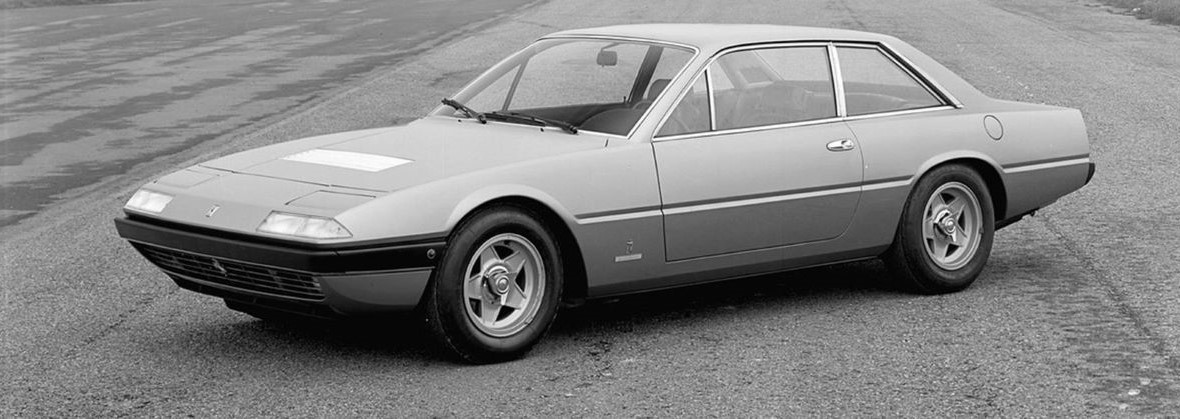
This was a brand new design from Pininfarina, which faced the task of developing a fast, svelte and elegant 2+2 powered by the classic VI2 engine that would break with the more classical lines of the 1967 365 GT 2+2 and provide greater rear seat space than that car’s successor, the 1970 GTC4. The resulting design marked the start of a new, fortuitous styling cycle that was to continue into the 400 and 412 series, with production eventually ending in 1989.
The 365 GT4 2+2 model was announced at the 1972 Paris Salon, and continued in production until 1976, when it was replaced by the 400 series. During this period a total of 521 examples, plus 3 prototypes were built, in the chassis number range 17091 to 19709. The bodies were mounted on a 2700mm wheelbase chassis, which apart from the longer wheelbase and a slightly wider rear track, was virtually identical to that of the 365 GTC/4 model, with factory type reference F101 AL, and all were numbered in the odd chassis number road car sequence. The model was available in right or left hand drive form, with power assisted steering as standard. The standard road wheels were alloy five spoke “star” pattern, with a knock off spinner on a Rudge hub. Borrani wire wheels were also available as an option, but rarely fitted, as they were beginning to look rather dated and out of place, on the more angular bodies that were in vogue in the seventies.
Internally it featured an instrument panel and centre console layout that was very similar to the preceding 365 GTC/4. However, externally the only common design elements were the twin retractable headlights in rectangular pods, five spoke alloy wheels, door handle design, and a triple circular rear light arrangement. The styling carried one feature from the 365 GTB/4 “Daytona” model, this being the semi circular indent line along the body sides, but was otherwise it was a completely new design from Pininfarina. The triple ear knock-off hub spinners and the triple rear light arrangement, are the most easily identifiable features to differentiate the 365 GT4 2+2 model from the succeeding similarly bodied 400/412 series. Due to the increasingly strict legislation in the USA, and the relatively high cost of engineering solutions to meet the requirements, on a low volume production car, no American market versions were built.
The engine was virtually identical to that of the 365 GTC/4 model, with twin overhead camshafts per bank of the 4.4 litre V12 unit, with wet sump lubrication, and side draught twin choke Weber 38 DCOE59/60 carburettors, with the same factory type reference number F 101 AC 000. The only notable difference was the provision of a twin coil and rear of engine mounted distributor ignition system, as opposed to the single system fitted to European market 365 GTC/4 models. The quoted power output was the same at 320bhp. The complete transmission system is of the same layout as that on the 365 GTC/4, with a lengthened propeller shaft due to the increased wheelbase, and different individual gear and final drive ratios. Similarly the suspension layout is almost identical, including the hydraulic rear self levelling system.
The bodies were built and fully trimmed at the Pininfarina works in Turin, and then shipped to the Ferrari factory in Maranello for the installation of the mechanical components. The body design is a relatively conservative three box shape, with a large cabin glass area, clean angular lines uncluttered by adornment, giving an impression of gentile refinement, exuding an air of sporting luxury. Only the long expanse of bonnet, the discreet Ferrari badges, including a chrome plated “Cavallino Rampante” in the centre of the under bumper radiator grille, and quadruple exhaust tailpipes, making any sort of power statement.
The upholstery was leather as standard, and the rear seats provided adequate space for adults in comfort, with good headroom, and adequate legroom. The large glass area made for a very light airy cabin, whilst the carpeted boot, although relatively shallow in depth, was deep, and capable of holding an adequate volume of luggage for four people. Electric windows and air conditioning were standard features of the model.
Engine
Type………………………………front, longitudinal 60° V12
Bore/stroke………………………81 x 71 mm
Unitary displacement…………..365.86 cc
Total displacement……………..4390.35 cc
Compression ratio……………….8.8 : 1
Maximum power…………………250 kW (340 hp) at 6200 rpm
Power per litre…………………..77 hp/l
Maximum torque…………………-
Valve actuation………………….twin overhead camshafts per bank, two valves per cylinder
Fuel feed………………………….six Weber 38 DCOE carburettors
Ignition……………………………single spark plug per cylinder, two coils
Lubrication……………………….wet sump
Clutch……………………………..single-plate
Chassis
Frame……………………………..tubular steel
Front suspension………………..independent, unequal-length wishbones,
coil springs over telescopic shock absorbers, anti-roll bar
Rear suspension…………………self-levelling, independent, unequal-length wishbones,
coil springs over telescopic shock absorbers, anti-roll bar
Brakes…………………………….discs
Transmission…………………….5-speed + reverse
Steering………………………….power-assisted recirculating-ball
Fuel tank…………………………capacity 102 litres
Front tyres……………………….215/70 VR 15
Rear tyres………………………..215/70 VR 15
Bodywork
Type………………………………2+2 coupé
Length……………………………4810 mm
Width……………………………..1796 mm
Height…………………………….1310 mm
Wheelbase……………………….2700 mm
Front track………………………1470 mm
Rear track………………………..1500 mm
Weight……………………………1500 kg (dry)
Performance
Top speed………………………..245 km/h


You must be logged in to post a comment.